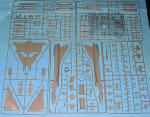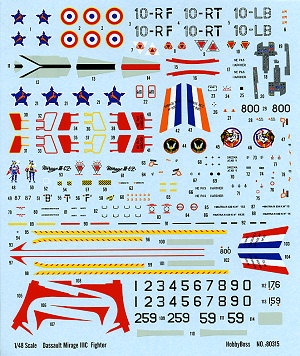
| KIT: | Hobby Boss 1/48 Mirage IIIC |
| KIT #: | 80315 |
| PRICE: | $22.00 from www.wingsntreads.com |
| DECALS: | Four options |
| REVIEWER: | Scott Van Aken |
| NOTES: |

| HISTORY |
The Mirage III family grew out of French government studies begun in 1952 that led in early 1953 to a specification for a lightweight, all-weather interceptor capable of climbing to 18,000 m (59,040 ft) in six minutes and able to reach Mach 1.3 in level flight.
Dassault's response to the specification was the Mystère-Delta 550, a sporty-looking little jet that was to be powered by twin Armstrong Siddeley MD30R Viper afterburning turbojets, each with thrust of 9.61 kN (2,160 lbf). A SEPR liquid-fuel rocket motor was to provide additional burst thrust of 14.7 kN (3,300 lbf). The aircraft had a tailless delta configuration, with a 5% chord (ratio of airfoil thickness to length) and 60 degree sweep.
The tailless delta configuration has a number of limitations. The lack of a horizontal stabilizer means flaps cannot be used, resulting in a long take-off run and a high landing speed. The delta wing itself limits maneuverability; and suffers from buffeting at low altitude, due to the large wing area and resulting low wing loading. However, the delta is a simple and pleasing design, easily built and robust, capable of high speed in a straight line, and with plenty of space in the wing for fuel storage.
The first prototype of the Mystere-Delta, without afterburning engine or rocket motor and an absurdly large vertical tailfin, flew on 25 June 1955. After some redesign, reduction of the tailfin to more rational size, installation of afterburners and rocket motor, and renaming to Mirage I, the prototype attained Mach 1.3 in level flight without the rocket, and Mach 1.6 with the rocket lit in late 1955.
However, the small size of the Mirage I restricted its armament to a single air-to-air missile, and even before this time it had been prudently decided the aircraft was simply too tiny to carry a useful warload. After trials, the Mirage I prototype was eventually scrapped.
Dassault then considered a somewhat bigger version, the Mirage II, with a pair of Turbomeca Gabizo turbojets, but no aircraft of this configuration was ever built. The Mirage II was bypassed for a much more ambitious design that was 30% heavier than the Mirage I and was powered by the new SNECMA Atar afterburning turbojet with thrust of 43.2 kN (9,700 lbf). The Atar was an axial flow turbojet, derived from the German World War II BMW 003 design.
The new fighter design was named the Mirage III. It incorporated the new area ruling concept, where changes to the cross section of an aircraft were made as gradual as possible, resulting in the famous "wasp waist" configuration of many supersonic fighters. Like the Mirage I, the Mirage III had provision for a SEPR rocket engine.
The prototype Mirage III flew on 17 November 1956, and attained a speed of Mach 1.52 on its seventh flight. The prototype was then fitted with the SEPR rocket engine and with manually-operated intake half-cone shock diffusers, known as souris ("mice"), which were moved forward as speed increased to reduce inlet turbulence. The Mirage III attained a speed of Mach 1.8 in September 1957.
The success of the Mirage III prototype resulted in an order for 10 preproduction Mirage IIIAs. These were almost two meters longer than the Mirage III prototype, had a wing with 17.3% more area, a chord reduced to 4.5%, and an Atar 09B turbojet with afterburning thrust of 58.9 kN (13,230 lbf). The SEPR rocket engine was retained, and the aircraft were fitted with Thomson-CSF Cyrano Ibis air intercept radar, operational avionics, and a drag chute to shorten landing roll.
The first Mirage IIIA flew in May 1958, and eventually was clocked at Mach 2.2, making it the first European aircraft to exceed Mach 2 in level flight. The tenth IIIA was rolled out in December 1959. One was fitted with a Rolls-Royce Avon 67 engine with thrust of 71.1 kN (16,000 lbf) as a test model for Australian evaluation, with the name "Mirage IIIO". This variant flew in February 1961, but the Avon powerplant was not adopted.
The first major production model of the Mirage series, the Mirage IIIC, first flew in October 1960. The IIIC was largely similar to the IIIA, though a little under a half meter longer and brought up to full operational fit. The IIIC was a single-seat interceptor, with an Atar 09B turbojet engine, featuring an "eyelet" style variable exhaust.
The Mirage IIIC was armed with twin 30 mm DEFA revolver-type cannon, fitted in the belly with the gun ports under the air intakes. Early Mirage IIIC production had three stores pylons, one under the fuselage and one under each wing, but a second outboard pylon was quickly added to each wing, for a total of five. The outboard pylon was intended to carry a Sidewinder air-to-air missile (AAM), later replaced by Matra Magic.
Although provision for the rocket engine was retained, by this time the day of the high-altitude bomber seemed to be over, and the SEPR rocket engine was rarely or never fitted in practice. In the first place, it required removal of the aircraft's cannon, and in the second, apparently it had a reputation for setting the aircraft on fire. The space for the rocket engine was used for additional fuel, and the rocket nozzle was replaced by a ventral fin at first, and an airfield arresting hook assembly later.
95 Mirage IIICs were obtained by the AdA, with initial operational deliveries in July 1961. The Mirage IIIC remained in service with the AdA until 1988. The type was also used with great success by the Israeli Air Force during the 1967 and 1973 wars. South African Mirage IIICZs remained in service for a considerable time due to a weapons embargo. Ex-Israeli Mirage IIICs were exported to other countries who wanted a capable aircraft but were unable to afford new aircraft or wanted to keep themselves free from any obligations to the US or other country.
The French Armée de l'Air (AdA) also ordered a two-seat Mirage IIIB operational trainer, which first flew in October 1959. The fuselage was stretched about a meter (3 ft 3.5 in) and both cannon were deleted to accommodate the second seat. The IIIB had no radar, and provision for the SEPR rocket was deleted, although it could carry external stores. The AdA ordered 63 Mirage IIIBs (including the prototype), including five Mirage IIIB-1 trials aircraft, ten Mirage IIIB-2(RV) inflight refueling trainers with dummy nose probes, used for training Mirage IVA bomber pilots, and 20 Mirage IIIBEs, with the engine and some other features of the multi-role Mirage IIIE. One Mirage IIIB was fitted with a fly-by-wire flight control system in the mid-1970s and redesignated Mirage IIIB-SV (Stabilité Variable); this aircraft was used as a testbed for the system in the later Mirage 2000.
| THE KIT |
 This is the second new Mirage IIIC kit to be produced in 1/48 scale in the last few years. Prior to this, Eduard did a kit that was lauded by many and built by few. I'm not really sure why this was as it certainly looked good in the box. It was also pricey, retailing at double what this kit sells for. Before that, there was the ancient Heller Mirage IIIB/C kit from the late 1960s. This kit apparently had some major fit problems, though it could be built as the two seat version.
This is the second new Mirage IIIC kit to be produced in 1/48 scale in the last few years. Prior to this, Eduard did a kit that was lauded by many and built by few. I'm not really sure why this was as it certainly looked good in the box. It was also pricey, retailing at double what this kit sells for. Before that, there was the ancient Heller Mirage IIIB/C kit from the late 1960s. This kit apparently had some major fit problems, though it could be built as the two seat version.
This one is all we have come to expect from a modern Chinese model maker. The surface detail is nicely engraved panel lines along with recessed rivet detail that you either like or hate. This detailing is not that great, but is there. I'm really not sure just exactly where this trend started, but the first kit I can recall having it was the Hasegawa 1/48 F-104 Starfighter.
 There are five major sprues with this kit and one clear sprue. Two of the five sprues are identical and carry a large array of weaponry and pylons. Naturally, not all are going to fit on the model at once, but you do get three optional large missiles (As 30, Matra 530C/K, Matra 530E/M), two sets of fuel tanks, four Snakeye bombs, two rocket pods, two Sidewinders and two Magic missiles. All are well molded though the air to air missile bodies have large ejector pin holes to fill.
There are five major sprues with this kit and one clear sprue. Two of the five sprues are identical and carry a large array of weaponry and pylons. Naturally, not all are going to fit on the model at once, but you do get three optional large missiles (As 30, Matra 530C/K, Matra 530E/M), two sets of fuel tanks, four Snakeye bombs, two rocket pods, two Sidewinders and two Magic missiles. All are well molded though the air to air missile bodies have large ejector pin holes to fill.
For the rest of the kit there is a nicely done cockpit with raised console detail. A five piece bang seat and separate rudder pedals. The wheel wells are made from several sections and have good detailing. I noticed that there is no intake trunking or blanking plate provided so I'm not sure if one will be needed. All of the elevons are provided as separate pieces, though to be honest, I don't recall seeing images of these in anything but the neutral position when the plane was on the ground. One is also provided with a boarding ladder and a positionable canopy.
Instructions are well done with Gunze paint references. There is also a load-out drawing to help decide what to put where under the wings. The large decal sheet is very nicely printed and quite colorful. The color placement guide shows four different aircraft; one in an overall light blue from EC 2/10, another EC 2/10 in unpainted metal with the earlier markings that have the tricolor rudder flash and red around the intakes, a desert camouflaged EC 3/10 aircraft and a similarly camouflaged aircraft from 2 Sq SAAF. The sheet also includes decals for the instrument panels and several markings that are not called out on the markings guide. For instance, a larger set of SAAF roundels and several sets of code letters in a different font from any used. The sheet also includes the dielectric panels for the fin, which is a nice touch and will save some painting.
| CONCLUSIONS |
If this is going to be typical of what we will be seeing from Hobby Boss in terms of aircraft kits, then I can foresee them doing very well. In the box this kit has all the right goodies and one isn't paying a fortune for it. I'm very much looking forward to building this and seeing how it turns out.
| REFERENCES |
Wikipedia
Thanks to www.wingsntreads.com for the review kit.
If you would like your product reviewed fairly and fairly quickly by asite that has over 350,000 visitors a month, please contactme or see other details in the